Table of contents
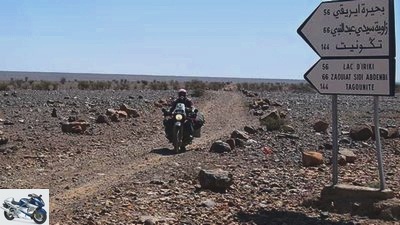
Brings
to travel
MOTORCYCLE on the road in Morocco
MOTORCYCLE on the road in Morocco
North Africa’s last gap
It has become tight in the northern Sahara. The fear of terror and police surveillance is increasingly pissing off travelers. Morocco seems to be the last bastion for desert fans between Atlas and Erg Chebbi.
Annette Johann
11/22/2007
The boat takes a long time. Actually, the ferry should have made the route between Sète in southern France and Tangier on the northern tip of Africa long ago, but there is still no country in sight. “Strong headwind,” argues the captain over the on-board loudspeaker. Over a beer, a sailor tells us that the decrepit engines can only manage 15 knots instead of 19 – delays are factored in. Regardless of the prospect of a four-week motorcycle vacation, a few hours do not matter.
Those arriving in Tangier receive mild temperatures. On the green coastal road it goes to the southeast, in the azure blue sea one bay is lined up after the next. But the idyll is deceptive, because there is a military or police post above almost every bay. In the past, the vigilance was mainly focused on drug traffickers, today, however, people smugglers trying to bring African refugees to Spain – preferably here along the Strait of Gibraltar, where the narrowest point is just 14 kilometers of water between Africa and Europe.
Buy complete article
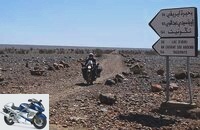
MOTORCYCLE on the road in Morocco
North Africa’s last gap
8 pages) as PDF
€ 2.00
Buy now
We too will soon have to deal with the power of order. At the hotel in El-Jebha, the local gendarme not only records our personal details, but also the details of our parents and grandparents. He also wants to know all of our places to stay over the next four weeks. Only the heavily laden GS with a tent, sleeping bags and other camping equipment convinced him that we ourselves do not yet know where we are going to sleep.
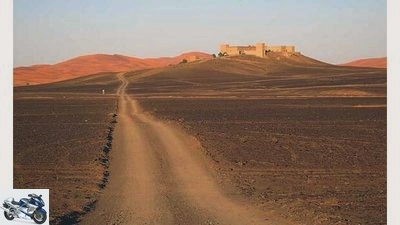
Merzouga on Erg Chebbi.
The coast remains behind as the ascent to the south into the Rif Mountains begins. Cherry trees in bloom soon give way to pine forests, and scattered snow remains along the wayside. The town of Ketama can only be passed at walking pace, because the weekly market is boiling there. All the spices of North Africa seem united, paprika, ginger, cumin, cinnamon, rosemary, thyme, coriander and saffron are lined up in colorful piles. The inhabitants also deal with completely different things: around Ketama, more hemp is grown than anywhere else in the world. The traders in the cafes and the shepherds in the pastures smoke their shit pipes as a matter of course.
The park-like landscape changes into rugged high mountains as we screw our way up into the Middle Atlas. With its 2400 meter pass, the Tizibou-Zabel marks not only the tree but also the climatic limit, on its south side there is a dry desert climate with little vegetation. Behind the pass, in Missour, we treat ourselves to the Hotel Baroudi, which is praised in the travel guide. Oh well. The three stars were probably painted by myself, the shop is dusty and musty, the sink is crooked, and the garden is like a garbage dump. The next morning we quickly set out for the Erg Chebbi dune area.
On its east side, the first slopes beckon at the edge of the dune. Since it rained heavily in autumn, the desert is astonishingly green with large, flowering meadows, speckled with nomad tents and cairns, the old signposts of the caravans. In the north of the Erg we discover a quarry with fossil finds from which beautiful tabletops are made – one of the few occasions in which one would want a car. So it is only enough for an ammonite as a souvenir.
On the following 260-kilometer stage between Taouz and Zagora, the desert shows all its fascinating varieties of off-road routes. So-called queds, dry river beds, want to be crossed and Fech-Fechs with their treacherous, powder-fine deep sand to be mastered. Sometimes the piste leads over wide plains, then between overgrown sand dunes, and finally over shiny black mountain ranges. Here, too, there is lush vegetation for desert conditions, and many nomads are on the move because of the good pasture land. The highlight of the encounters is a clan with at least 200 camels. At the end of the caravan, the mules loaded with tents and household items march.
The qued near Hassi Remlia looks difficult, with deep sand and ruts running through the river bed. But there is no point in worrying. With a courageous twist on the gas, we make it to the other side in no time and continue bumpy over stony slopes. Cafes and hostels pop up at regular intervals. As isolated as the area may seem – you are never really alone. There is nobody to be seen for miles around, but as soon as you stop to pee, someone is there immediately. Sometimes the thought arises that Moroccans are not conceived in the normal way, but grow out of the ground like mushrooms.
Orientation is not always easy because of the numerous branches, on the last stretch to Zagora the corrugated iron shakes you up quite a bit. Then the asphalt is reached again – but not for long. Behind Mhamid, past palm groves and dunes, through a wide wadi again out onto a slope. We cross the desert plain towards Lac Iriki, which with the impressive Jbel Bani mountain range in the background offers a strong panorama. In addition, the hard clay soil of the lake is a good base for the GS’s studded tires; What it looks like here after rain falls, however, one would rather not imagine.
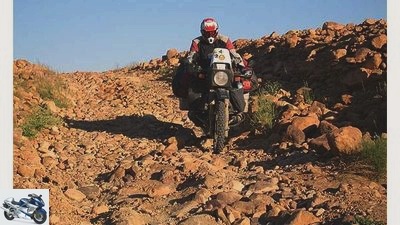
Only possible with good tires: piste between Lac Iriki and Foum Zguid.
In the Anti-Atlas we take another off-road route behind Tata, which soon ends in a ravine. The path narrows constantly, leads over smooth stone slabs and through deep gravel. And meanders through palm gardens, surrounded by almost vertical, bare rocks, the rocks of which shimmer colorfully. At the end of the gorge, the route climbs in steep curves to an almost 2000 meter high plain where the almond trees are in bloom. The small villages seem deserted, apparently they are only inhabited in summer. A few kilometers further, the piste plunges down into another wadi in dizzying serpentines. We follow the gravel, palm-fringed river bed to the west, only 20 kilometers before Tafraoute we hit the road again.
Argania, rare trees that are wider than they are tall and whose crowns reach a diameter of up to 14 meters, grow here in southwest Morocco. The argan oil is extracted from the seeds of its fruits, and European gourmets pay 80 euros and more per liter for its fine nut taste. The goats of the nomads who enjoy themselves in the treetops also enjoy the fruits. Allegedly, some Berber women pull the seeds out of the goat droppings in order to process them further.
During a stopover in Marrakech, we celebrate my 50th birthday in the midst of snake charmers, jugglers and storytellers; The highlight of the party is a musician with a black rooster on his head. But soon we are drawn back from the hustle and bustle of the city towards the High Atlas. Between the Tizi-n-Test and Tizi-n-Tichka passes, there is a spectacular slope that winds its way through deep valleys and along wild rivers and higher and higher into the mountains. Until the scenery becomes high alpine. Before Âït-Benhaddou, the largest kasbah in Morocco, it goes steeply downhill over heels with scree – not an easy undertaking with the heavy BMW, but can be mastered thanks to years of off-road experience.
Another highlight lies in the north of the Atlas Mountains, the Todra Gorge. At its narrowest point, it measures only ten meters, and its red rock walls soar up to 300 meters into the sky. Behind this narrow point, a storm has torn the asphalt with it, but there are no particular difficulties. Not so in the subsequent Dadès Gorge. The slanted stone slabs at the beginning are still easy to cope with. Then the route runs in an almost dry river bed, which we have to leave regularly over a steep embankment because large rocks block the way. And then it happens: the rear wheel slips away on the loose scree of the embankment and we fall a few meters. This is where nomad women camp, of all places, and they start begging while we are still lying under the motorcycle – they may think that Europeans always dismount like that. Fortunately, the fall came off lightly.
Finally, at 2800 meters, a magnificent view over the rugged mountains into the green river valley makes up for it. On the way down into the actual gorge it gets warmer and greener, the rocks give way to fields and fields, poplars, fig, walnut and apple trees grow on the banks of the Dadès, then the path leads through wild oasis gardens; the contrast between barren desert and lush green oases is completely inspiring. After this exhausting day we treat ourselves to a night in a lovingly restored kasbah in Bou-Thrarar – with good food and a wonderful view of the Valley of the Roses.
One last time it is time to cross the High Atlas to get to the waterfalls of Ouzoud. It’s getting cold and colder, and at some point it starts to snow. We step on the gas to get the mountains behind us as quickly as possible. Lo and behold, on the north side of the Atlas, the snow is melting under the bright sun. The waterfalls plunge over several levels over red sintered terraces around 100 meters deep into a fertile valley. Monkeys frolic in the crowns of the fig and olive trees.
On secondary routes we make our way to Fès, the oldest and most beautiful of the four royal cities of Morocco. It’s worth hiring a guide here. For example, to attend a Koran school where children learn the suras by heart, or to watch craftsmen who have long since ceased to exist here – tinkerers, dyers, coppersmiths, turners, weavers. It smells bad in the Gerber Quarter, but the scenery is absolutely colorful. The finished leather is processed on the spot to make seat cushions, sandals and purses. The next day we let ourselves drift in the tumult of the souks, sit on Place Nejjarine with a mint tea and just look. Dignified old men pass by on their way to the mosque, children fetch water from a well over 300 years old, women stop for a chat. We end the day in a restaurant at Bab Boujeloud, a door to the old town decorated with faience.
Our four weeks are drawing to a close, we are approaching Tangier. But before we say goodbye, there is another big celebration: In a restaurant in the harbor we celebrate the 18th birthday of our BMW with a grandiose fish platter.
Info
Apart from Tunisia, Morocco is the last North African country that can still be traveled individually and relatively safely. In addition, its scenic and urban diversity offers even newcomers to Africa few hurdles and a lot of adventure.
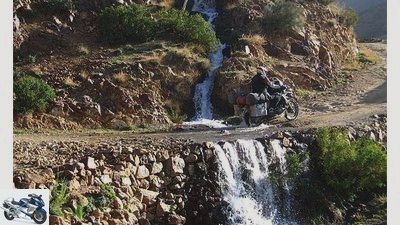
Part of the High Atlas: river crossings west of the Tizi-n-Tichka.
getting there
There are several ways to get to Morocco. Ferry ships leave from several Spanish ports between Sète in the south of France (the longest crossing with 36 hours, from around 270 euros for a person with a motorcycle) and the Spanish city of Algeciras (around two hours, around 75 euros). Those who shy away from the long motorway journey in winter (to Sète from Karlsruhe 890 kilometers, to Algeciras 2300) can also take the motorail train to Narbonne. It is then only 70 kilometers to Sète. A person with a motorcycle pays in a couchette car from 260 euros one way. Details at www.db.autozug.de. Information on ferries can be found on the Internet portals www.aferry.de, www.marokkotours.de and www.yalla-off-road.de. Traveling to Agadir with a bike is even more comfortable. Information on this at www.bikeworld-travel.de.
entry
You need a passport that is still valid for at least six months and a green insurance card that includes Morocco. Warning – some companies have canceled Morocco. In such cases, take out short-term liability insurance at the border. A German driver’s license and vehicle license are sufficient. Important: In theory, the import of GPS devices must be applied for. However, since checks are seldom carried out, it is sufficient to put the device in your luggage. Later nobody cares anymore.
Travel time
Many mountain roads can be closed from December to February. Sometimes it is freezing cold and the days are quite short. In addition to October / November, March and April are again ideal. In the desert it is not yet too hot and in the mountains the snow has already melted. While winter is often still prevalent in Germany in March, the almond trees are already in bloom in the Anti-Atlas and the cherry trees in the Rif mountains.
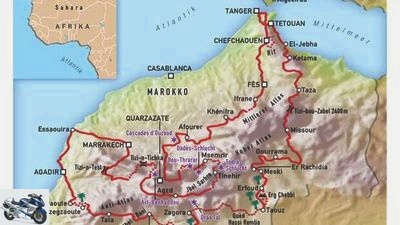
Duration of the trip: four weeks; Distance covered: around 5000 kilometers.
Stay
There are so many hotels and campsites that you hardly have to worry about accommodation for the night. In our opinion, the best campsite was »Camping Atlas« at the beginning of the Todra Gorge. A well-kept place where, if you wish, you can have breakfast in the morning and good food in the evening and even a washing machine. The blatant counterpart: “Camping La Palmeraie” in Agzd. Recommended in the travel guide to be clean and good, it turned out to be completely neglected, and the bill was only correct after tough negotiation. Among the hotels, we particularly liked the CTM Hotel in Marrakech. The double rooms are small but clean, have a shower / toilet and cost only 16 euros per night including breakfast (motorcycle garage: one euro surcharge). The best thing, however, is the location on Djema-el-Fnaa. The roof terrace offers a great view over the hustle and bustle of the center. The Panorama Hotel on a hill in front of Merzouga also offers a clear view, in this case over the entire Erg Chebbi. The price is negotiable, the two of us paid 40 euros with half board. In Bou-Thrarar we can recommend the Gite d‘etappe by El Houssine Azabi, a lovingly restored old kasbah: friendly operators, good food and a fantastic view from the terrace of a fertile valley. Here, too, we paid 40 euros for half board. The owner also leads trekking tours in the surrounding mountains.
security
The Foreign Office (www.auswaertiges-amt.de) advises greater caution in tourist areas and in the vicinity of mosques because of attacks. Also in the Rif mountains between Chefchaouen, Ketama and Fès because of the cannabis cultivation. In the past, tourists were sometimes urged to buy hashish there. And later promptly got into massive problems with the police, who rigorously pursued drug possession. Our experience: The offers were made, but the rejection was always accepted.
Finances / prices
The local currency is the dirham, and there are around eleven of them for one euro. Every bank changes cash, and in almost all cities you can withdraw cash from ATMs by credit and mostly also by EC card. Paying by card is only possible in luxury hotels. For five euros there is a good meal, for twice as much a whole menu. Campsites for two people with a motorcycle cost between two and six euros, a double room in a hotel between ten and 20 euros.
motorcycling
Morocco is accessible by good asphalt roads and can therefore also be explored with street motorcycles. However, an enduro provides more opportunities, as many scenic highlights can be discovered off the beaten track. The petrol station network (also for unleaded ones) is so dense that a range of 350 kilometers is sufficient even on the slopes. Prepare the motorcycle as well as possible, as the spare parts supply in Morocco is unfortunately not working properly. Possibly conclude a letter of protection. There is even a branch of the ADAC in Agadir: Sigrid Graete, phone 028/843752.
Further information
The volume »Morocco. From the Rif to the Anti Atlas «by Erika and Astrid Darr, Verlag Reise Know-How, for 25 euros. However, route descriptions may differ in reality, because on the one hand more and more asphalt is being paved and on the other hand severe weather often completely changes the slopes. Good maps: Michelin’s Morocco papers or Reise Know-How.
A map is also available for free download at www.Island-olaf.de. This is not very precise in the north and the Rif, but has correctly drawn every smallest slope in the south. The website of the Moroccan tourist office provides some suggestions, hotel tips et cetera: www.tourismus-in-marokko.de. An interesting forum moderated by the authors Erika and Astrid Darr, among others, is www.forum.marokko.net. Always up to date, but in English: www.horizonsunlimited.com.
Related articles
-
Morocco motorcycle tour for Africa beginners
Iron ham to travel Morocco motorcycle tour for Africa beginners Morocco motorcycle tour for Africa beginners Allah’s wild rock garden Mysterious cities,…
-
MOTORCYCLE On the Road: Tunisia
Huh to travel MOTORCYCLE On the Road: Tunisia On the way: Tunisia Wind, sand and stars Tunisia attracts with beach and sun. Those who only go on vacation…
-
shepherd to travel Motorcycle tour in Morocco Motorcycle tour in Morocco Side effects welcome As one of the world’s most diverse countries, Morocco is an…
-
On the road in Denmark by motorcycle
Daams 14th pictures Daams 1/14 Time for the rain suit: a short shower on the way to Tyboren. Motorcycling in Denmark between the North Sea and the Baltic…
-
Motorcycle tour through Algeria
to travel Motorcycle tour through Algeria Motorcycle tour through Algeria The dunes of the Sahara Algeria. The grave road, the sand dunes from Erg…
-
Kirchgebner to travel On the way: Morocco On the way: Morocco Between heaven & Earth No country in North Africa offers such diversity. Mountains over…
-
to travel Morocco Morocco So close – so strange An enduro tour through the bitter Atlas Mountains takes you into the magical and strange world of the…
-
Breakable 22nd pictures Breakable 1/22 Island happiness: The slender streets of the Isle of Mull enchant especially around the highest mountain Ben More…
-
Motorcycle road trip through Germany
Henniges 30th pictures Henniges 1/30 Henniges 2/30 There are wonderful middle ways between cutting down a tree and leaving it standing. Henniges 3/30 The…
-
MOTORCYCLE on the road: Baltic States
Kirsten Fiege to travel MOTORCYCLE on the road: Baltic States MOTORCYCLE on the road: Baltic States Experience of loneliness Hardly any curves and only…